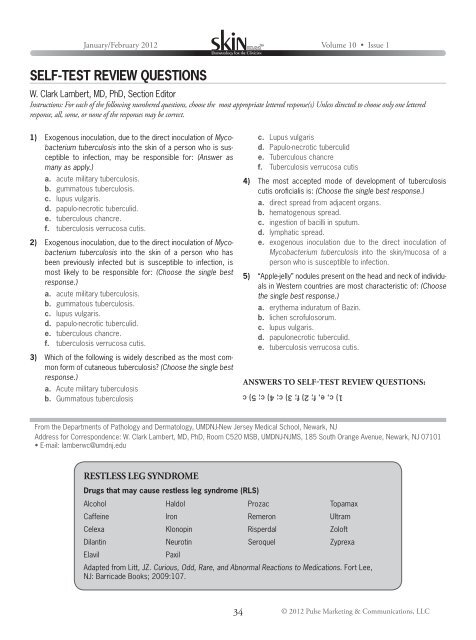January/February 2012 • Volume 10 • Issue 1 - SKINmed Journal
January/February 2012 • Volume 10 • Issue 1 - SKINmed Journal
January/February 2012 • Volume 10 • Issue 1 - SKINmed Journal
Create successful ePaper yourself
Turn your PDF publications into a flip-book with our unique Google optimized e-Paper software.
<strong>January</strong>/<strong>February</strong> <strong>2012</strong><br />
SELF-TEST REVIEW QUESTIONS<br />
34<br />
<strong>Volume</strong> <strong>10</strong> <strong>•</strong> <strong>Issue</strong> 1<br />
W. Clark Lambert, MD, PhD, Section Editor<br />
Instructions: For each of the following numbered questions, choose the most appropriate lettered response(s) Unless directed to choose only one lettered<br />
response, all, some, or none of the responses may be correct.<br />
1) Exogenous inoculation, due to the direct inoculation of Mycobacterium<br />
tuberculosis into the skin of a person who is susceptible<br />
to infection, may be responsible for: (Answer as<br />
many as apply.)<br />
a. acute military tuberculosis.<br />
b. gummatous tuberculosis.<br />
c. lupus vulgaris.<br />
d. papulo-necrotic tuberculid.<br />
e. tuberculous chancre.<br />
f. tuberculosis verrucosa cutis.<br />
2) Exogenous inoculation, due to the direct inoculation of Mycobacterium<br />
tuberculosis into the skin of a person who has<br />
been previously infected but is susceptible to infection, is<br />
most likely to be responsible for: (Choose the single best<br />
response.)<br />
a. acute military tuberculosis.<br />
b. gummatous tuberculosis.<br />
c. lupus vulgaris.<br />
d. papulo-necrotic tuberculid.<br />
e. tuberculous chancre.<br />
f. tuberculosis verrucosa cutis.<br />
3) Which of the following is widely described as the most common<br />
form of cutaneous tuberculosis? (Choose the single best<br />
response.)<br />
a. Acute military tuberculosis<br />
b. Gummatous tuberculosis<br />
c. Lupus vulgaris<br />
d. Papulo-necrotic tuberculid<br />
e. Tuberculous chancre<br />
f. Tuberculosis verrucosa cutis<br />
4) The most accepted mode of development of tuberculosis<br />
cutis oroficialis is: (Choose the single best response.)<br />
a. direct spread from adjacent organs.<br />
b. hematogenous spread.<br />
c. ingestion of bacilli in sputum.<br />
d. lymphatic spread.<br />
e. exogenous inoculation due to the direct inoculation of<br />
Mycobacterium tuberculosis into the skin/mucosa of a<br />
person who is susceptible to infection.<br />
5) “Apple-jelly” nodules present on the head and neck of individuals<br />
in Western countries are most characteristic of: (Choose<br />
the single best response.)<br />
a. erythema induratum of Bazin.<br />
b. lichen scrofulosorum.<br />
c. lupus vulgaris.<br />
d. papulonecrotic tuberculid.<br />
e. tuberculosis verrucosa cutis.<br />
ANSWERS TO SELF-TEST REVIEW QUESTIONS:<br />
1) c, e, f; 2) f; 3) c; 4) c; 5) c<br />
From the Departments of Pathology and Dermatology, UMDNJ-New Jersey Medical School, Newark, NJ<br />
Address for Correspondence: W. Clark Lambert, MD, PhD, Room C520 MSB, UMDNJ-NJMS, 185 South Orange Avenue, Newark, NJ 07<strong>10</strong>1<br />
<strong>•</strong> E-mail: lamberwc@umdnj.edu<br />
RESTLESS LEG SYNDROME<br />
Drugs that may cause restless leg syndrome (RLS)<br />
Alcohol Haldol Prozac Topamax<br />
Caffeine Iron Remeron Ultram<br />
Celexa Klonopin Risperdal Zoloft<br />
Dilantin Neurotin Seroquel Zyprexa<br />
Elavil Paxil<br />
Adapted from Litt, JZ. Curious, Odd, Rare, and Abnormal Reactions to Medications. Fort Lee,<br />
NJ: Barricade Books; 2009:<strong>10</strong>7.<br />
© <strong>2012</strong> Pulse Marketing & Communications, LLC


